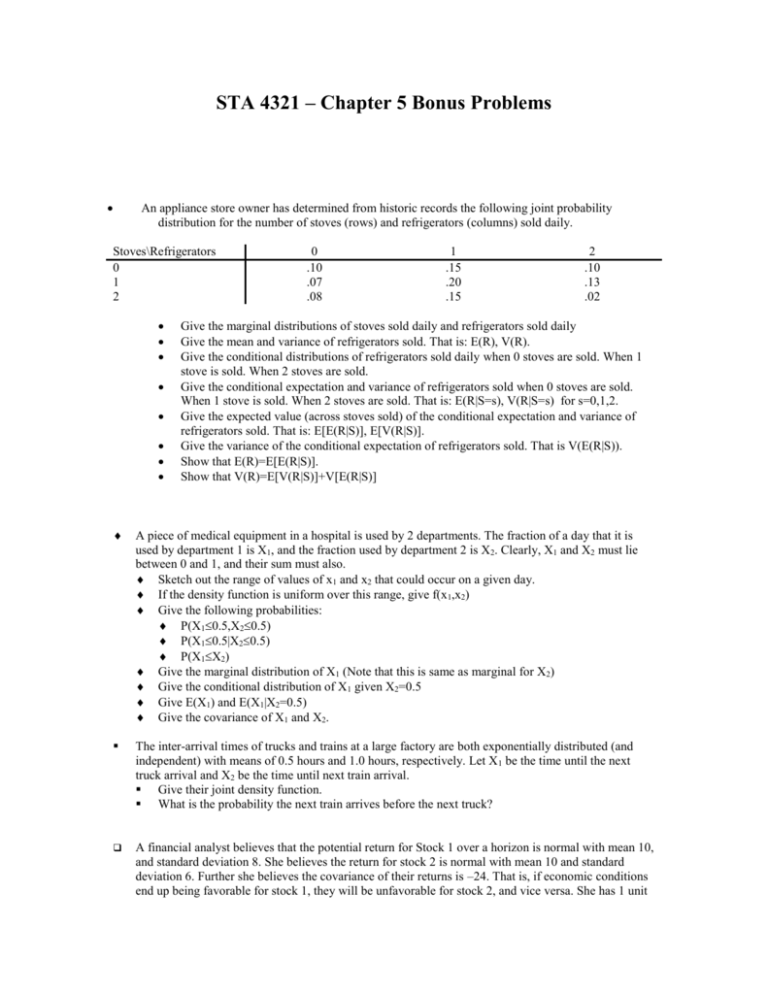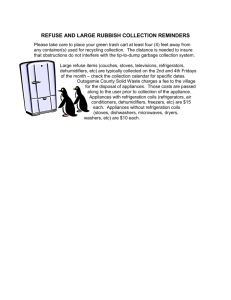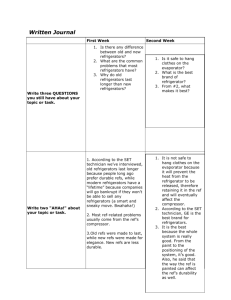Bonus Problems (Also see Political Poll example)
advertisement

STA 4321 – Chapter 5 Bonus Problems An appliance store owner has determined from historic records the following joint probability distribution for the number of stoves (rows) and refrigerators (columns) sold daily. Stoves\Refrigerators 0 1 2 0 .10 .07 .08 1 .15 .20 .15 2 .10 .13 .02 Give the marginal distributions of stoves sold daily and refrigerators sold daily Give the mean and variance of refrigerators sold. That is: E(R), V(R). Give the conditional distributions of refrigerators sold daily when 0 stoves are sold. When 1 stove is sold. When 2 stoves are sold. Give the conditional expectation and variance of refrigerators sold when 0 stoves are sold. When 1 stove is sold. When 2 stoves are sold. That is: E(R|S=s), V(R|S=s) for s=0,1,2. Give the expected value (across stoves sold) of the conditional expectation and variance of refrigerators sold. That is: E[E(R|S)], E[V(R|S)]. Give the variance of the conditional expectation of refrigerators sold. That is V(E(R|S)). Show that E(R)=E[E(R|S)]. Show that V(R)=E[V(R|S)]+V[E(R|S)] A piece of medical equipment in a hospital is used by 2 departments. The fraction of a day that it is used by department 1 is X1, and the fraction used by department 2 is X2. Clearly, X1 and X2 must lie between 0 and 1, and their sum must also. Sketch out the range of values of x1 and x2 that could occur on a given day. If the density function is uniform over this range, give f(x 1,x2) Give the following probabilities: P(X10.5,X20.5) P(X10.5|X20.5) P(X1X2) Give the marginal distribution of X1 (Note that this is same as marginal for X2) Give the conditional distribution of X1 given X2=0.5 Give E(X1) and E(X1|X2=0.5) Give the covariance of X1 and X2. The inter-arrival times of trucks and trains at a large factory are both exponentially distributed (and independent) with means of 0.5 hours and 1.0 hours, respectively. Let X 1 be the time until the next truck arrival and X2 be the time until next train arrival. Give their joint density function. What is the probability the next train arrives before the next truck? A financial analyst believes that the potential return for Stock 1 over a horizon is normal with mean 10, and standard deviation 8. She believes the return for stock 2 is normal with mean 10 and standard deviation 6. Further she believes the covariance of their returns is –24. That is, if economic conditions end up being favorable for stock 1, they will be unfavorable for stock 2, and vice versa. She has 1 unit that she can invest in the 2 firms. She cannot purchase a negative portion of either stock (sell short) and she wants to spend the entire unit on investing. Let p be the proportion she spends on stock 1 and (1-p) be what she spends on stock 2. What is her expected return? What is the variance of her return (as a function of p)? She is risk averse and wants to minimize the variance of her return. What value of p should she choose? A law firm has offices in 3 cities. The number of new referrals in a week is a Poisson random variable with mean i (i=1,2,3) for city i. Further, the numbers of new referrals in a week are independent across cities. Give the distribution of the number of new referrals per week making use of the moment generating function and independence. A high-end art gallery owner finds that the number of potential customers entering his shop follows a Poisson distribution with a mean of =12 per day. Further, the probability that an individual potential customer makes a purchase is p=0.10. Customer purchase outcomes are independent. Let C=the number of potential customers on a given day, and S=the number of sales on the same day. Give P(C=c) and P(S=s|C=c) Give E(C) and V(C) Give E(S|C=c) and V(S|C=c) Give E[E(S|C)], V[E(S|C)], E[V(S|C)] Give E(S) and V(S)





